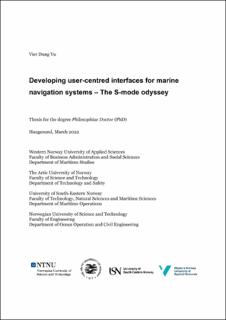Developing user-centred interfaces for marine navigation systems – The S-mode odyssey
Doctoral thesis
Published version

Åpne
Permanent lenke
https://hdl.handle.net/11250/3021683Utgivelsesdato
2022Metadata
Vis full innførselSamlinger
- Import fra CRIStin [3604]
- Institutt for maritime studier [198]
Originalversjon
Vu, V. D. (2022). Developing user-centred interfaces for marine navigation systems – The S-mode odyssey [Doctoral dissertation, Western Norway University of Applied Sciences]. HVL Open.Sammendrag
Human factors, also known as ergonomics, is an area not properly considered when designing shipboard navigation equipment. This shortcoming results in some design issues which pose a risk to safe and efficient maritime operations. The International Maritime Organisation [IMO] has attempted to address this problem through regulatory incentive by developing new guidelines and regulations, an example of which is circular MSC.1/Circ.1609 - Guidelines for the Standardisation of User Interface Design for Navigation Equipment, also known as the “S-mode guidelines”.
The S-mode guidelines introduce recommended design practices and standardise four features on the interfaces of navigation equipment. In this thesis, the development of the S-mode guidelines is analysed from two aspects, first as a design project with the design object being the interfaces of navigation equipment, and second as a joint effort from various stakeholders in the maritime industry, including the author of this thesis.
This thesis has two goals. The first goal is, through the work conducted to develop S-mode, to provide technical knowledge to support the design of future navigation equipment. The outcome of this goal includes information on the context of use for navigation equipment, usability issues to consider when using icons on navigational displays, and a recommended pattern to organise essential control functions on the interfaces of Radar and ECDIS.
The second goal is to identify contextual factors that shaped the development of S-mode and provide relevant stakeholders with recommendations to consider when developing similar future regulatory instruments. The findings suggest future design guidelines and regulations should address the requirements of both the end-users and system manufacturers. Support from influential maritime states is important to get approval at the IMO. The structure and working arrangement of the IMO do not facilitate rapid innovation and it is more realistic for aim for gradual improvements.
Future research should advance the applicability of the design recommendations introduced in this thesis by conducting studies to include functionalities of navigation systems not considered in S-mode, or by performing summative tests with high-fidelity prototypes to validate the effectiveness of those recommendations.
Also, the scope of this thesis is limited to the development of the S-mode guidelines and does not include the implementation phase. Future research, therefore, should investigate the implementation of S-mode and evaluate the guidelines’ impacts on the industry.
Beskrivelse
Articles I and III are published by Cambridge University Press and © The Royal Institute of Navigation. Reused with permission.
Består av
Vu, V. D., Lützhöft, M., & Emad, G. R. (2019). Frequency of use – the First Step Toward Human-Centred Interfaces for Marine Navigation Systems. Journal of Navigation, 72(5), 1089-1107. https://doi.org/10.1017/s0373463319000183Vu, V., & Lutzhoft, M. (2019). Standard icons for control functions on navigation systems – design and issues. Paper presented at Ergoship 2019 Conference, Haugesund, Norway.
Vu, V. D., Lutzhoft, M., & Imset, M. (2022). Logical grouping of data and control functions on the displays of shipboard navigation systems. Journal of Navigation, 75(3), 507-527. https://doi.org/10.1017/s0373463322000157
Vu, V., Lutzhoft, M., & Imset, M. (2022a). Developing human factors engineering guidance for marine electronics - the case of S-mode. paper under review at WMU Journal of Maritime Affairs.